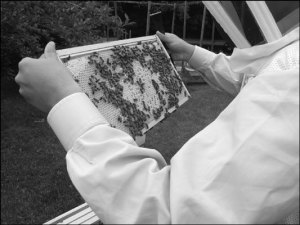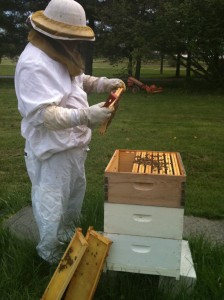Psalms from the Hive
by Jeannie Saum
Interesting! Cool!
Guess what we did?
You should have gone!
Dad put in a bid
For a hive from the bee yard.
At the end of the season
It will be his to keep on pleasin’.
Clover, Bee, and Revery
Reverie (revery) –(n.) state of dreamy meditation or fanciful musing; a fantastic, visionary, or impractical idea.
They’re back from the Bee Yard – Steve, and our daughter and son, Sarah and Nate – and  bouncing off the wall. They are so excited by what they saw and learned and spent a full hour regaling me with their enthusiasm. They watched hive inspections, learned to identify different members of the bee colony, looked for evidence of mites and moths and saw a bar top hive. Many of the new hives were built by COBA and were up for dibs, to buy at the end of the season, after being used for instruction. Of course, Steve had to have one, the benefit being that at the end of the summer, he gets a strong healthy hive that has been well taken care of. So come fall, he will be the proud owner of a third hive! It’s official, he’s in deep!
bouncing off the wall. They are so excited by what they saw and learned and spent a full hour regaling me with their enthusiasm. They watched hive inspections, learned to identify different members of the bee colony, looked for evidence of mites and moths and saw a bar top hive. Many of the new hives were built by COBA and were up for dibs, to buy at the end of the season, after being used for instruction. Of course, Steve had to have one, the benefit being that at the end of the summer, he gets a strong healthy hive that has been well taken care of. So come fall, he will be the proud owner of a third hive! It’s official, he’s in deep!
How to Perform a Basic Beehive Inspection
By Howland Blackiston from Beekeeping For Dummies, 2nd Edition
Beekeepers always follow certain procedures and always look for certain things. After a few visits to the hive, the mechanics of all this become second nature, and you can concentrate on enjoying the miraculous discoveries that await you.
Removing the first frame of the hive
Always begin your inspection of the hive by removing the first frame or wall frame. That’s the frame closest to the outer wall. Which wall? It doesn’t matter. Pick a side of the hive to work from, and that determines your first frame. Here’s how to proceed:
- Insert the curved end of your hive tool between the first and second frames, near one end of the frame’s top bar.
- Twist the tool to separate the frames from each other.
- Repeat this motion at the opposite end of the top bar.
- Using both hands, pick up the first frame by the end bars.

- removing a frame
Now that you’ve removed the first frame, gently rest it on the ground, leaning it vertically up against the hive. It’s okay if bees are on it. They’ll be fine. Or, if you have a frame rest (a handy accessory available at some beekeeping supply stores) use it to temporarily store the frame.
Use your hive tool to pry the wall frame loose before removing it.
Working your way through the hive
Using your hive tool, loosen frame two and move it into the open slot where frame one used to be. That gives you enough room to remove this frame without the risk of injuring any bees. When you’re done looking at this frame, return it to the hive, close to (but not touching) the wall. Do not put this frame on the ground.
Work your way through all ten frames in this manner, moving the next frame to be inspected into the open slot. When you’re done looking at a frame, always return it snugly against the frame previously inspected. Use your eyes to monitor progress as the frames are slowly nudged together.

- work through all the frames
Holding up beehive frames for inspection
Holding and inspecting an individual frame the proper way is crucial. Be sure to stand with your back to the sun, with the light shining over your shoulder and onto the frame. The sun illuminates details deep in the cells and helps you to better see eggs and small larvae.

- hold it up and look at fro all angles
Here’s an easy way to inspect both sides of the frame:
- Hold the frame firmly by the tabs at either end of the top bar.
- Turn the frame vertically.
- Then turn the frame like a page of a book.
- Now smoothly return it to the horizontal position, and you’ll be viewing the opposite side of the frame.
Knowing when it’s time for more smoke
A few minutes into your inspection, you may notice that the bees all have lined up between the top bars like racehorses at the starting gate. Their little heads are all in a row between the frames. Kind of cute, aren’t they? They’re watching you. That’s your signal to give the girls a few more puffs of smoke to disperse them again so that you can continue with your inspection.
Understanding what to always look for in your hive
Each time that you visit your hive, be aware of the things that you always must look for. Virtually all inspections are to determine the health and productivity of the colony. The specifics of what you’re looking for vary somewhat, depending upon the time of year.
Checking for your queen bee
Every time that you visit your hive you’re looking for indications that the queen is alive and well and laying eggs. Rather than spending time trying to see the queen, look for eggs. Although they’re tiny, finding the eggs is much easier than locating a single queen in a hive of 60,000 bees. Look for eggs on a bright, sunny day.
Storing food and raising the bee brood
Each deep frame of comb contains about 7,000 cells (3,500 on each side). Honeybees use these cells for storing food and raising brood. When you inspect your colony, noting what’s going on in those cells is important because it helps you judge the performance and health of your bees.
Inspecting the brood pattern
Examining brood pattern is an important part of your inspections. A tight, compact brood pattern is indicative of a good, healthy queen. Conversely, a spotty brood pattern (many empty cells with only occasional cells of eggs, larvae, or capped brood) is an indication that you have an old or sick queen and may need to replace her.
Recognizing foodstuffs in your beehive
Learn to identify the different materials collected by your bees and stored in the cells. They’ll pack pollen in some of the cells. Pollen comes in many different colors: orange, yellow, brown, gray, blue, and so on. You’ll also see cells with something “wet” in them. It may be nectar. Or it may be water.
Psalm 92
1 It is good to give thanks to the LORD, to sing praises to your name, O Most High;
2 to declare your steadfast love in the morning, and your faithfulness by night,
3 to the music of the lute and the harp, to the melody of the lyre.
4 For you, O LORD, have made me glad by your work; at the works of your hands I sing for joy.
5 How great are your works, O LORD! Your thoughts are very deep!










Recent Comments